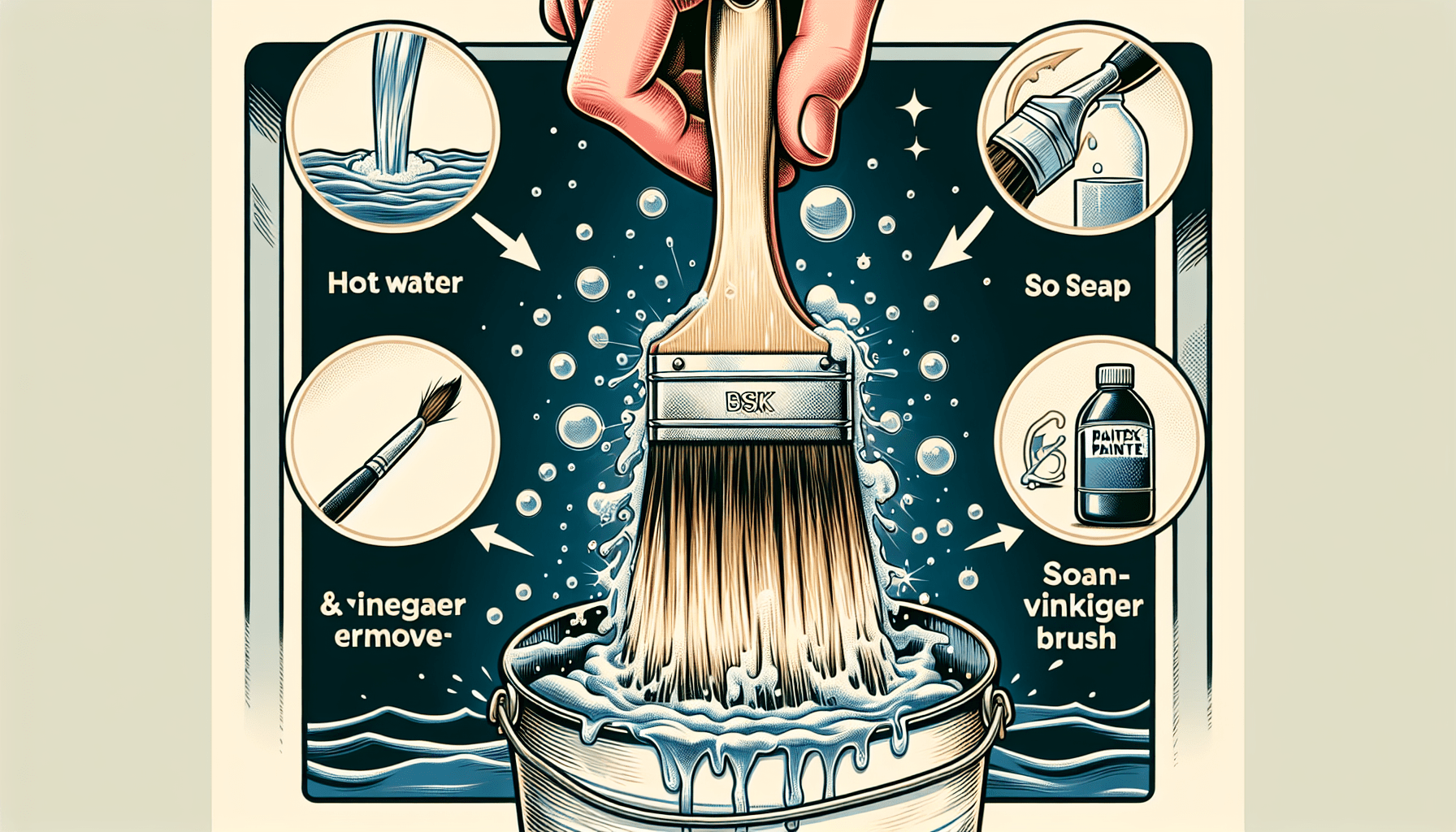In the realm of home improvement projects, knowing how to properly thin latex paint for a sprayer can be a valuable skill to possess. Whether you are repainting a room or tackling a larger scale renovation, using a sprayer can provide a more efficient and professional finish. However, understanding the technique and steps required for thinning latex paint is essential to achieve optimal results. This article will guide you through the process, ensuring that you are equipped with the knowledge and expertise to thin latex paint effectively for your sprayer, resulting in a flawless and smooth application.
Why Thin Latex Paint
Benefits of thinning latex paint for sprayer
When using a sprayer to apply latex paint, thinning the paint is often necessary to achieve the best results. Thinning the paint helps to improve its consistency and flow, allowing for smoother and more even coverage on the surface being painted. This is particularly important when using a sprayer, as the paint needs to be able to pass through the nozzle and be evenly distributed onto the surface. Thinning the paint also helps to prevent clogging of the sprayer, ensuring a consistent spray pattern and reducing the chances of any blockages.
Thinning latex paint for a sprayer also allows for greater control over the application process. With a thinner paint, it is easier to achieve a desired level of opacity or transparency, depending on the desired finish. Thinned paint also tends to dry more quickly, which can be advantageous when working on larger areas or in environments with higher temperatures or humidity levels. Additionally, thinning latex paint can help to reduce the amount of paint used, as it can cover a larger surface area with the same amount of paint.
When thinning latex paint is necessary
Thinning latex paint is generally necessary when using a sprayer, as the paint needs to be in a more fluid state to effectively pass through the sprayer’s nozzle. However, there are other factors that may contribute to the need for thinning the paint. For instance, if the paint has become too thick over time due to exposure to air or changes in temperature, thinning it can help restore its original consistency. Likewise, if the paint is brand new but is thicker than desired, thinning it can help achieve the desired viscosity for optimal application. Ultimately, the decision to thin latex paint will depend on the specific project and the recommendations of the paint manufacturer.
Types of Latex Paint
Water-based latex paint
Water-based latex paint, also known as acrylic latex paint, is the most common type of latex paint used for a variety of indoor and outdoor applications. This type of paint is made from water-soluble polymers that bind the pigments together, creating a durable and flexible finish. Water-based latex paint is known for its versatility, ease of use, and quick drying time. It can be applied to a wide range of surfaces, including wood, metal, and concrete, making it suitable for both interior and exterior projects.
Acrylic latex paint
Acrylic latex paint is a specific type of water-based latex paint that is made with acrylic resins. These resins enhance the durability and adhesion of the paint, making it suitable for high-traffic areas and surfaces that require frequent cleaning. Acrylic latex paint is known for its excellent color retention, resistance to fading, and ability to withstand harsh weather conditions. It is often used for exterior painting projects, such as painting siding, trim, and outdoor furniture. However, it can also be used for interior applications, providing a durable and long-lasting finish.
Preparation
Gather necessary materials
Before thinning latex paint for a sprayer, it is important to gather all the necessary materials. This includes the latex paint itself, a measuring container or cup, a stir stick, water (if using the water-thinning method), a paint conditioner or flow aid (if using that method), and a paint extender (if using that method). Having all the materials ready in advance will help ensure a smooth and efficient thinning process.
Choose an appropriate location
When thinning latex paint for a sprayer, it is important to choose an appropriate location for the task. Ideally, this should be a well-ventilated area, such as a garage or outdoor space, to minimize the inhalation of fumes. It is also important to consider the surrounding surfaces and objects, as thinning paint can be messy. Covering nearby surfaces with drop cloths or plastic sheets can help protect them from any accidental spills or splatters.
Protect the work area
In addition to choosing an appropriate location, it is also important to protect the work area when thinning latex paint. This includes removing any valuable or delicate items from the vicinity to prevent them from being accidentally damaged. Using drop cloths or plastic sheets to cover the floor and adjacent surfaces can help catch any drips or splatters, making cleanup easier. It is also advisable to wear gloves and long sleeves to protect your skin from contact with the paint.
Wear protective gear
When thinning latex paint for a sprayer, it is crucial to wear the appropriate protective gear to ensure personal safety. This includes wearing safety glasses or goggles to protect your eyes from any splashes or airborne particles. A respirator or mask should also be worn to prevent inhalation of paint fumes or particles. It is important to choose a respirator or mask that is specifically designed for use with paint and provides adequate filtration.

Determining the Right Consistency
Consult the paint manufacturer’s instructions
Before thinning latex paint, it is recommended to consult the paint manufacturer’s instructions for guidance on the appropriate thinning ratio. The manufacturer’s instructions will provide specific information on how much water or other thinning agent should be added to achieve the desired consistency. Following these instructions will help ensure that the paint is properly thinned and will adhere well to the surface being painted.
Using a viscosity cup
A viscosity cup is a tool that can be used to measure the consistency of paint. To determine the right consistency for thinning latex paint, fill the viscosity cup with the paint and then slowly pour the paint back into the original container while timing how long it takes for the paint to flow through the cup’s opening. Comparing this time to the recommended flow time in the paint manufacturer’s instructions can help determine if the paint needs to be thinned further or if it is already at the desired consistency.
Trial and error method
If specific instructions are not available or you prefer a more hands-on approach, the trial and error method can be used to determine the right consistency. This involves thinning a small amount of paint and testing it on a scrap piece of material or a inconspicuous area of the surface being painted. If the paint flows smoothly and evenly without any clogging or spattering, it is at the right consistency. If it is too thick or viscous, additional thinning may be required.
Methods to Thin Latex Paint
Adding water
Adding water is one of the most common and straightforward methods of thinning latex paint. It is important to note, however, that not all latex paints can be thinned with water. It is best to consult the paint manufacturer’s instructions to ensure that water is an appropriate thinning agent for the specific paint being used. If water is recommended, the following steps can be followed to thin the paint effectively.
Using a paint conditioner or flow aid
A paint conditioner or flow aid can be used as an alternative to water for thinning latex paint. These products are specifically designed to improve the flow and workability of the paint, resulting in a smoother and more even application. Paint conditioners and flow aids are readily available at most paint supply stores and come in different formulations that are compatible with various types of latex paint. It is important to follow the manufacturer’s instructions when using these products to ensure optimal results.
Using a paint extender
A paint extender is another option for thinning latex paint, particularly if you want to extend the drying time or enhance the leveling properties of the paint. Paint extenders are additives that are specifically formulated to increase the open time of paint, allowing for better blending of brush marks or roller stipple. When using a paint extender, it is important to choose a product that is compatible with the type of latex paint being used and to follow the manufacturer’s instructions for proper usage.
Thinning Latex Paint with Water
Gradually add water
To thin latex paint with water, start by pouring a small amount of paint into a separate container. Gradually add water to the paint, stirring continuously with a stir stick or paint mixer. It is important to add water slowly and in small increments, as adding too much water at once can make the paint too thin and lead to poor adhesion and coverage. Continue adding water and stirring until the desired consistency is reached.
Mix thoroughly
Once the water has been added, it is important to mix the paint thoroughly to ensure the water is evenly distributed. Use a stir stick or paint mixer to thoroughly blend the water and paint together. This will help achieve a consistent and even thinning throughout the paint, resulting in a smoother application.

Test the consistency
Before using the thinned paint in the sprayer, it is important to test the consistency to ensure it is appropriate for spraying. This can be done by spraying a small test pattern onto a scrap piece of material or onto an inconspicuous area of the surface being painted. Observing how the paint flows through the sprayer and how it appears on the surface will help determine if any further thinning or adjustment is necessary.
Using Paint Conditioner or Flow Aid
Follow manufacturer’s instructions
When using a paint conditioner or flow aid to thin latex paint, it is essential to follow the manufacturer’s instructions for proper usage. Different products may have different recommendations in terms of the amount of conditioner or flow aid to be added and the mixing process. Deviating from these instructions can negatively impact the performance of the paint and may result in an uneven or unsatisfactory finish.
Mix the conditioner into the paint
To thin latex paint with a conditioner or flow aid, add the recommended amount of the product to the paint. This can typically be done by pouring the conditioner directly into the paint container or by measuring it out separately and then adding it to the paint. Once the conditioner or flow aid has been added, use a stir stick or paint mixer to thoroughly mix it into the paint, ensuring it is evenly distributed.
Stir until well blended
After adding the conditioner or flow aid, it is important to stir the paint until it is well blended. Take care to thoroughly mix the conditioner or flow aid with the paint to ensure optimal thinning and performance. A properly blended paint will have a uniform consistency and flow smoothly through the sprayer, resulting in a more even and professional-looking finish.
Using Paint Extender
Choose a compatible paint extender
When using a paint extender to thin latex paint, it is important to choose a product that is compatible with the specific type of latex paint being used. Different paint extenders are formulated for different types of paint and may have varying recommendations for usage. Consult the manufacturer’s instructions to ensure the paint extender is suitable and safe to use with the chosen latex paint.
Add the extender to the paint
To thin latex paint with a paint extender, add the recommended amount of the product to the paint. This can typically be done by pouring the extender directly into the paint container or by measuring it out separately and then adding it to the paint. It is important to follow the manufacturer’s instructions for the proper amount to add, as adding too much extender can alter the performance and drying time of the paint.
Mix well until desired consistency is achieved
Once the paint extender has been added, use a stir stick or paint mixer to thoroughly mix it into the paint. Take care to fully incorporate the extender into the paint to ensure optimal thinning and performance. Continue stirring until the desired consistency is achieved. It may be necessary to add additional extender or adjust the amount of paint in order to achieve the desired consistency.
Testing the Thinned Paint
Spray a test pattern
Before fully committing to using the thinned latex paint, it is important to spray a test pattern onto a scrap piece of material or onto an inconspicuous area of the surface being painted. This will allow you to observe how the thinned paint flows through the sprayer and how it appears on the surface. It will also help determine if any further thinning or adjustments are needed to achieve the desired coverage and finish.
Adjust the consistency if needed
Based on the test pattern, if the thinned latex paint does not spray evenly or does not provide the desired coverage, it may be necessary to make further adjustments to the consistency. This could involve adding more water, paint conditioner, flow aid, or extender, depending on the method used for thinning. It is important to make these adjustments gradually and in small increments, testing the consistency after each adjustment until the desired results are achieved.
Cleaning the Sprayer
Disassemble the sprayer
After completing the painting project, it is important to properly clean the sprayer to maintain its performance and prolong its lifespan. Start by disassembling the sprayer according to the manufacturer’s instructions. This typically involves removing the spray tip, nozzle, and other removable parts. Take care to follow the manufacturer’s instructions to prevent any damage or loss of components.
Flush with water or appropriate solvent
Once disassembled, flush the sprayer with water or an appropriate solvent to remove any residual paint. This can be done by connecting the sprayer to a water source or using a spray bottle to apply water or solvent directly to the sprayer’s components. Flushing the sprayer thoroughly will help remove any paint particles and prevent clogging or buildup that could affect its performance.
Clean and dry all components
After flushing the sprayer, clean all the components with a brush or cloth to remove any remaining paint or debris. Pay special attention to small crevices and hard-to-reach areas to ensure a thorough cleaning. Once clean, rinse the components with water or solvent to remove any cleaning agents or residue. Finally, allow all the components to air dry completely before reassembling the sprayer or storing it for future use.
Thinning latex paint for a sprayer is a crucial step in achieving a smooth and professional finish. By following the necessary preparations, selecting the appropriate thinning method, and testing the consistency, you can ensure optimal results. Remember to always consult the paint manufacturer’s instructions and take safety precautions when working with paint and a sprayer. With the right techniques and tools, you can achieve excellent results and make your painting projects a success.


